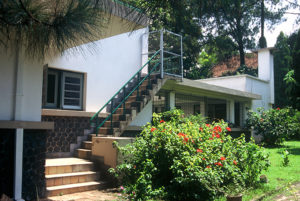

For some time now, heritage professionals and enthusiasts in Semarang have been lobbying the government and UNESCO to appreciate and acknowledge the significance of Kota Lama. While everybody seems up in arms to preserve this part of Semarang, significant buildings in other parts of town are ignored and not taken care off. What, for example, is going to happen to one of the extraordinary houses in the hills that was recently put up for sale? Is it on the brink of disappearing, or can and will it be saved and cherished?
Gesamtkunstwerk
The house I am referring to is inextricably linked to Semarang and Indonesian history. Commissioned by a Semarang resident, the house was designed by Semarang born and based architect Liem Bwan Tjie in 1934. The first ‒ and unfortunately only ‒ time I visited the house and gardens, my jaw dropped. First of all because of the location: a vast, partially sloping plot of land that offered an uninterrupted view over Semarang all the way to the Java Sea. Secondly because of the remarkable flat-roofed modernist design of the house and its lush garden. And finally, because of the house’s original interior. An interior for which Liem Bwan Tjie singlehandedly designed the geometric stained glass and all furniture: tables, chairs and light fixtures. This house was a Gesamtkunstwerk in the true sense of the word: a work of art in which all separate elements were conceived and designed as one entity/artefact.
Care takers
Although taken somewhat aback by my candid enthusiasm, the then owners/occupants – heirs/children of the initial commissioner – greatly appreciated it. They recognised and took great pride in the remarkable architecture of their home. When some time later friends of mine went over to see the house, they had completely repainted the house: the house looked stunning. Over the years, the house and its delightful owners regularly crossed my mind. It always felt good, knowing the piece of Semarang architectural heritage was appreciated and lovingly cared for by its owners.
House for sale


Last year though, my confidence in the future of the house was fundamentally shaken. Just days after I spotted a ‘for sale’ sign on the estate’s gate, Liem’s daughter contacted me. She was worried. If a bid was made, she and I realised, it would probably not be prompted by the house’s architecture, but rather by its location and plot size. Which, as so often happens in Indonesia in general and in this area in Semarang in particular, in all probability would imply the new owner would demolish the house and garden and instead build a new and financially more lucrative construction: a luxury hotel annex restaurant, or an upmarket apartment block.
What’s next
While it can be hoped the house will be purchased by somebody who appreciates its history and quality, the odds are that it is on the brink of destruction. Not because the house is not of monumental value, but because the house was never identified and listed as such. As with so many monumental buildings in Semarang, it simply is not on Semarang’s heritage list. And thus, while local, national and international attention is being paid to Kota Lama, equally interesting and relevant areas in Semarang remain ignored and outlawed to the caprices of the economic market.
Who cares?
The question is why this happens time and again? Why do so few people seem aware or care about the loss, or at best invasive ‘conversions’ of monumental houses in Semarang? How come, the government and architecture enthusiasts ignore buildings that in many countries around the world would be listed as a monument?
The Liem Bwan Tjie house that is currently up for sale has got all it takes: historical, social and architectural relevance. Had the house been listed as heritage, its continued existence would have been guaranteed – at least on paper. For, had it been listed, its sale would have implied an agreement to keep and save the building – on paper at least.
Icon of Indonesian architecture

Although all may not be lost yet for this outstanding Liem Bwan Tjie house in Semarang, it is time to turn the tide. While obviously Kota Lama has its qualities, many other areas in Semarang are also have plenty to offer in terms of buildings and lay-out. With regard to the Liem Bwan Tjie house, all one can hope for is that its buyer recognises and appreciates the building for what it is, and treats it accordingly: as a remarkable piece of early twentieth century Indonesian architecture, designed by an Indonesian architect for an Indonesian commissioner.
Epilogue

The need to publish this text as a blog illustrates the lack of urgency in Indonesia in general and Semarang in particular. Despite many efforts over the last year to get the Indonesian translation published in Indonesian newspapers and/or journals and despite several promises, the text remained unpublished.
©All photographs are taken in 1998 by Rinandi Chandra Aditya, Jakarta.